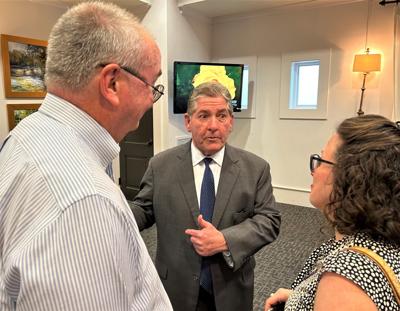FLORENCE — The University of South Carolina hopes to unveil plans and developers for nearly 900 acres behind its football team facilities this summer, Athletics Director Ray Tanner said.
The university asked developers in February to submit development ideas for the property that stretches to the Congaree River. The university received responses from more than two dozen groups and will start meeting with developers this month, Tanner said May 8.
"I hope we are in a position — potentially this summer — that we can roll out something where you can start to understand ... that this is something the university is going to do," Tanner told the Florence Rotary Club.
The property, Tanner said, is a blank canvas. The development groups were asked, "Here's the property, what would you do?"
The opportunities are endless, he said. Property surrounding professional and some college sports stadiums includes restaurants and entertainment areas.
"We have a lot of land. Is it big enough for a golf course? Could be. Is that something we will do? I'm not 100 percent sure," Tanner said.
The Post and Courier reported May 7 the property might be used for hotels, student housing and a technology hub.
When a plan is finalized, the university will continue to own the property and could potentially realize $1 billion in private investment. It could also receive funding through revenue sharing with the developers, he said.
The university will use the money to upgrade iconic Williams-Brice Stadium and other athletic facilities, Tanner said.
Williams-Brice has the second fewest number of suites in the Southeastern Conference. Vanderbilt has the fewest, Tanner said.
"We could use a lot more suites and club spaces," he said. "We added four club spaces during the pandemic, and that's been a fruitful investment for us as well."
Tanner also discussed how the NCAA's rules change to allow student-athletes to profit from endorsement deals and the transfer portal has changed college athletics.
Many endorsement deals are set up through "collectives" — separate third-party businesses typically formed by university boosters or fans.
"They are the groups that are handling name, image and likeness for student-athletes," he said.
The university can advise student-athletes they need to pay taxes on the endorsement income or other issues. It can't negotiate endorsement deals, he said.
Tanner said he believes that will change eventually and endorsement deals will be handled by the athletics department.
The transfer portal also has impacted recruitment of high school athletes, Tanner said. The portal allows student-athletes to transer to another university without any penalties, such as being forced to sit out a year of competition.
Only the best high school student-athletes will receive scholarships. Coaches are turning to the transfer portal to find experienced student-athletes for their programs, he said.
"You know who really gets hurt in this — the high school athlete," Tanner said. "Think about graduating seniors in Florence that may be really good athletes, but they don't get the same opportunities they got five years ago because if you're a coach are you going to take a 21 year old with experience at the Division 1 level or are you going to take a high school kid?"









